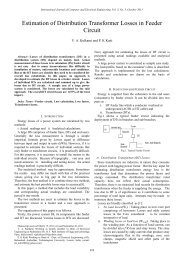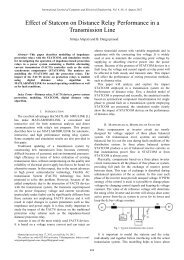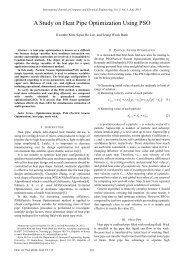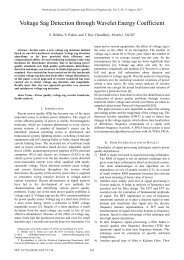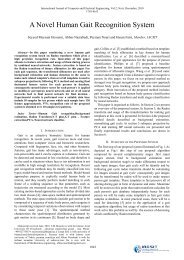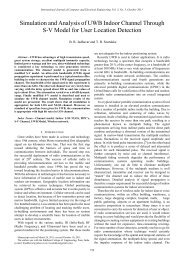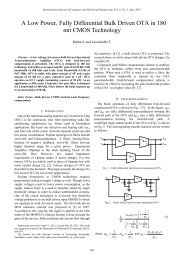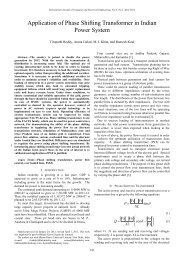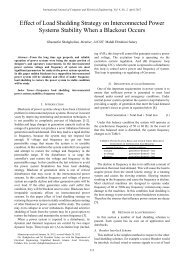Modified ABC Algorithm for Generator Maintenance Scheduling - ijcee
Modified ABC Algorithm for Generator Maintenance Scheduling - ijcee
Modified ABC Algorithm for Generator Maintenance Scheduling - ijcee
You also want an ePaper? Increase the reach of your titles
YUMPU automatically turns print PDFs into web optimized ePapers that Google loves.
International Journal of Computer and Electrical Engineering, Vol. 3, No. 6, December 2011<br />
<strong>ABC</strong><br />
<strong>Modified</strong> <strong>ABC</strong><br />
<strong>ABC</strong><br />
<strong>Modified</strong> <strong>ABC</strong><br />
0.95<br />
2.50E+07<br />
Reliability Index<br />
0.9<br />
0.85<br />
0.8<br />
0.75<br />
Fitness<br />
2.00E+07<br />
1.50E+07<br />
1.00E+07<br />
5.00E+06<br />
0.7<br />
1 1000 1999 2998 3997 4996<br />
Iterations<br />
0.00E+00<br />
1 1000 1999 2998 3997 4996<br />
Iterations<br />
Fig. 4. Reliability index versus iterations <strong>for</strong> case 1<br />
The M<strong>ABC</strong> is seen to produce the most reliable schedule<br />
compared with <strong>ABC</strong> over 5000 trials. The result reveals that<br />
M<strong>ABC</strong> produce better maintenance schedules then <strong>ABC</strong>.<br />
B. Case 2: 21 Unit System [11]<br />
In order to test the per<strong>for</strong>mance of the M<strong>ABC</strong> algorithm,<br />
the same sample system is considered with the system peak<br />
load demand of 4739 MW, and 35 crew available each week<br />
<strong>for</strong> the maintenance work [11]. The complete maintenance<br />
schedule is obtained by MDPSO, MS-MDPSO, <strong>ABC</strong> and<br />
M<strong>ABC</strong> is given in Table 2.<br />
In the MDPSO algorithm the weeks 23 & 35, the weeks 30<br />
& 36 in MS-MDPSO algorithm and the weeks 26, 33, 40 &<br />
52 in <strong>ABC</strong> and the weeks 25, 26, 32, 39, 40, 50, 51 & 52 in<br />
M<strong>ABC</strong> represents the low maintenance activities that is no<br />
unit is scheduled <strong>for</strong> maintenance. From the comparison it is<br />
clear that the M<strong>ABC</strong> algorithm produce the improved<br />
maintenance schedules then existing algorithms. The weekly<br />
available generation and crew requirements are depicted in<br />
Figs. 5 and 6 respectively.<br />
Available Generation (MW)<br />
MDPSO MS-MDPSO <strong>ABC</strong><br />
<strong>Modified</strong> <strong>ABC</strong> Load Demand (4739 MW) Max. Generation (5688 MW)<br />
5900<br />
5700<br />
5500<br />
5300<br />
5100<br />
4900<br />
4700<br />
1 11 21 31 41 51<br />
<strong>Maintenance</strong> Period (Weeks)<br />
Fig. 5. Available generation of case 2<br />
MDPSO MS-MDPSO <strong>ABC</strong> <strong>Modified</strong> <strong>ABC</strong> Max. Crew (35)<br />
Reliability Index<br />
0.95<br />
0.9<br />
0.85<br />
0.8<br />
0.75<br />
0.7<br />
0.65<br />
0.6<br />
Fig. 7. Fitness versus iterations <strong>for</strong> case 2<br />
1 1000 1999 2998 3997 4996<br />
Iterations<br />
<strong>ABC</strong><br />
<strong>Modified</strong> <strong>ABC</strong><br />
Fig. 8. Reliability index versus iterations <strong>for</strong> case 2<br />
C. Case 3: 13 Unit System [12]<br />
The test system consists of 13 generating units with the<br />
system peak load with 6.5% spinning reserve is 2500 MW,<br />
available man power <strong>for</strong> maintenance per week is limited to<br />
40 and the maximum generation is 3150 MW [12]. The<br />
complete maintenance schedules obtained by DPSO,<br />
MDPSO and <strong>ABC</strong> are presented in Table 3. In DPSO and<br />
MDPSO algorithms entire 26 weeks the maintenance<br />
activities are carried out resulting in high available<br />
generation is not possible. The <strong>ABC</strong> algorithm reaches the<br />
high available generation of 3150 MW in week 13 since no<br />
units is scheduled <strong>for</strong> maintenance whereas the proposed<br />
M<strong>ABC</strong> algorithm produce the better maintenance schedules<br />
in terms of attains the high available generation in the weeks<br />
14, 25 and 26. The weekly available generation and crew<br />
requirements are plotted in Fig. 9 & 10 respectively. From the<br />
comparison it is clear that the proposed <strong>ABC</strong> algorithm<br />
produce the better maintenance schedules than existing<br />
algorithms.<br />
DPSO MDPSO <strong>ABC</strong> M<strong>ABC</strong> Max. Gen (3150 MW) Load (2500 MW)<br />
Crew<br />
40<br />
35<br />
30<br />
25<br />
20<br />
15<br />
10<br />
5<br />
0<br />
1 4 7 10 13 16 19 22 25 28 31 34 37 40 43 46 49 52<br />
<strong>Maintenance</strong> Period (Weeks)<br />
Available Generation (MW)<br />
3200<br />
2900<br />
2600<br />
2300<br />
1 6 11 16 21 26<br />
<strong>Maintenance</strong> Period (Weeks)<br />
Fig. 6. Crew requirements of case 2<br />
Fig. 9. Available generation of case 3<br />
All the algorithms are satisfying the load requirements and<br />
crew requirements excepting MDPSO. The MDPSO<br />
algorithm does not satisfy the crew requirement on week 8<br />
due to heightened maintenance activities carried out<br />
simultaneously on units 3, 6 and 11. The convergence of the<br />
objective function and reliability index are presented in fig. 7<br />
& 8 respectively. The converged results clearly present<br />
minimization of the objective function and the optimization<br />
process demonstrates the capabilities of the M<strong>ABC</strong> algorithm<br />
in minimizing large variations of system net reserve in case<br />
they occur<br />
Crew<br />
50<br />
40<br />
30<br />
20<br />
10<br />
0<br />
DPSO MDPSO <strong>ABC</strong> M<strong>ABC</strong> Max. Crew (40)<br />
1 6 11 16 21 26<br />
<strong>Maintenance</strong> Period (Weeks)<br />
Fig. 10. Crew requirements of case 3<br />
816



